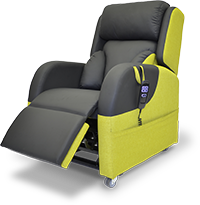A Tilt in Space (TiS) chair is ideal whenever you’re considering a specialist or pressure-relief seating solution for elderly chair or disabled chair users. But what makes it such a safe and effective option? And how can you be sure you’re using Tilt in Space chairs correctly? Follow our 8-step guide to find out and consider hiring a Tilt in Space chair and enjoy a more supportive lifestyle!
An effort-saving solution
Unlike a back angle recline (BAR) chair, a TiS function allows you to tilt the entire chair while maintaining the same deep angle between seat and backrest. So lifting and positioning the user is a far easier task – gravity does a lot of the work usually demanded of family or carers! Equally, if the user has enough mobility and balance, tilting both seat and backrest forward at the same angle can make getting into and out of the chair a far less challenging effort.
The ability of a Tilt in Space chair to provide a reclined resting and upright seating position that maintains the user’s posture is another significant advantage. It means the person expends far less energy attempting to stay comfortable, giving them more capacity to actually enjoy other activities.
TiS and BAR – the perfect combination
Tilt in Space also has a crucial role in the management of pressure. As posture is proven to affect pressure going through a body, achieving and retaining the optimum body position is critical. Combining TiS with BAR functions allows pressure to be regularly relieved, and repositioning carried out with minimum fuss. Merging the two functions also provides the flexibility needed to cater for the specific requirements of each individual chair user.
The right way to use a Tilt in Space chair – our 8-step guide
1. Changing of position
A simple change of position, by just a few degrees every hour, helps enormously with pressure relief. Not only that, it minimises the amount of time your elderly or disabled user(s) need to spend in bed.
2. Is the seat width correct?
Getting the seat width correct is absolutely vital – you should be looking for an inch either side of the person. If the chair is too small, it can cause them to become unnecessarily hot, leading to sweating, skin breakdown and pressure issues. Equally, if the seat is too wide, it can lead to poor posture or body positioning.
3. Is the seat depth correct?
Does it provide the user with full leg-length support?
4. Tilt and raise
The simple act of tilting the chair back and raising the user’s legs higher can increase blood flow, so should be carried out at regular intervals.
5. Angle adjustment for legs and feet
To prevent the user from sliding forward, you should elevate the legs and support the feet using angle adjustment.
6. Tilt slowly
We advise that you stand over the chair and apply pressure down onto the chair before tilting, to tilt it back slowly. And it’s sensible to do the same when you’re putting the chair back into position. This prevents the user from shooting forward too quickly!
7. Explain what’s happening
Whether you’re adjusting the headrest or tilting the chair, always let the user know what you’re doing, to avoid unwanted surprises. This will prevent them from moving suddenly and possibly causing injury.
8. Keep a ‘tilting log’
It’s a good idea to print off a ‘daily tilting log’ to attach to the back of the chair. This means carers can easily record and check when the chair was last tilted and make sure it’s done regularly. We can provide you with a tilting log to print out, contact us to request yours.
Of course, this is just a quick guide to a few of the key considerations you need to bear in mind when operating a Tilt in Space (TIS) chair. As members of the British Healthcare Trades Association (BHTA), Premiere Healthcare are experts in the provision, installation and ongoing servicing of specialists chairs for elderly and disabled users.
So if you’d like more in-depth guidance on choosing specialist seating that’s right for you or your client, please don’t hesitate to get in touch. We have assessors all over the country who can come out and do home visits free of charge, and bring some chairs along to try on the day.
To book an assessment or find out more, please contact us or call us on 0345 521 1819.









